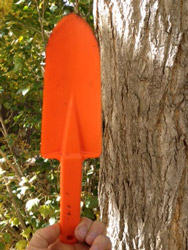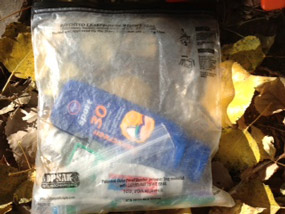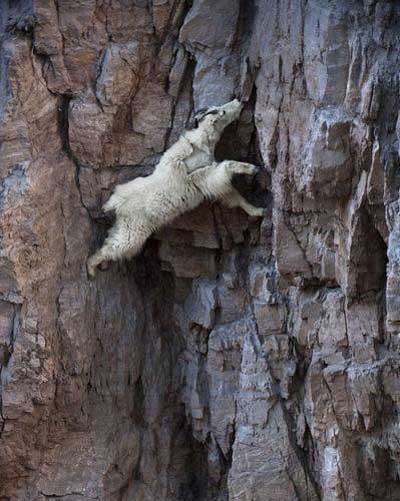If you’re in nature & nature calls, whip out toilet paper, a trowel and start digging! Seriously.
When you’ve got to go, you’ve got to go. That’s true wherever you are. Whether out for just a day or on a multi-day hike covering miles and miles of mountainside or forested trail, you’ve got to know how to go the bathroom in the woods. It’s the right ethics when in nature.
Just like our bed, stove, food and everything else we need, we bring the facilities with us when we’re out in nature. And just like in “civilization”, there are rules for using them outdoors. The Leave No Trace principles regarding the outdoors applies here, too, although we know we have to leave something behind. There’s just a right way (and a wrong way) to do it.
I remember being out for an overnight hike in Yellowstone National Park when nature called. Traipsing off to find a little privacy, I thought I had all the bases covered, but it turns out I committed several cardinal sins of outdoor bathroom use: being too close to water, too close to camp and too close to the trail.
Best Lessons for Going the Bathroom In Nature
First and foremost, make sure you’re at least 200 feet from any stream, lake or river. It’s important to be far from water because human waste is filled with germs that can cause waterborne parasites to fester and get others (perhaps not you) sick.
Make sure you’re the same distance from your campsite and the trail, too. Human waste will attract critters, so do what you can to not call attention to your whereabouts. There are also aesthetic reasons to do it right. A lot of other people are likely using or will use the same trail, and it’s doubtful that anybody else wants to see or smell our intestinal jetsam.
So we’re clear on that. When picking a spot, give water, the trail and the campsite a WIDE berth. This is vital stuff.
Procedure for Going Potty in Nature

Trowel for Digging Poop Holes
Then there is the matter of procedure. While we’re all well-equipped and well-trained to do our business at home, there can be a learning curve when doing it in the woods.
First, find an appropriate spot, preferably in an area other hikers aren’t liable to wander into. For individuals, the Leave No Trace method instructs us to dig what’s called a cathole— a six- to eight-inch deep hole. Underbrush doesn’t count. It’s got to be in the soil. It helps to pack a small trowel for just this purpose.
After taking care of the business, bury the waste thoroughly and cover the upturned earth with ground cover. Remember, no one else wants to find your spot. Human waste remains a biohazard for as long as a year after it’s deposited, so burying and disguising it properly is imperative for aesthetic and health reasons.
TP or No TP
Hikers generally bring TP along for bathroom breaks, and there are a couple of different schools of thought regarding its disposal. Provided it’s unscented, white paper, some say it’s alright to bury it along with the waste. It will, in time, break down, but it can still prove to be a blight on the landscape.
When we’re out in nature, we pack the paper back out. Stuffing it into a sealable, plastic bag is easy and a good way to leave no trace. You might also consider a WAG bag, basically a single-use fill-up station that you tote out. These bags contain a powder that deodorizes the waste and compacts it for easier carrying. The bags themselves are also approved for the landfill. This is the very best way to leave no trace.
However, I would never use one of these in bear country. Instead, I’d recommend:

An Odor Proof Bag – Ideal for Dirty TP or Toiletries
The bag we use is above. It’s called an OPSAK![]() . It uses a Leakproof, Airtight Seal that makes it ideal for packing out toilet paper, as well as packing in toiletries if you’re camping in bear country.
. It uses a Leakproof, Airtight Seal that makes it ideal for packing out toilet paper, as well as packing in toiletries if you’re camping in bear country.
An alternative to TP is to user one of Mother Nature’s wipes. Find a few soft leaves (not waxy leaves!) to clean up with, burying them along with the waste. Make sure you test the leaves out first by rubbing them against a less-sensitive part of your body FIRST to ensure no allergic reaction. That would be a real pain in the…
We personally have never experimented with that strategy, but to each their own.
But What About Snow?
Depending on the time of year, the procedure can differ a little. If you’re hiking through snow, the ground might be harder to dig, but dig you must (and don’t just bury it under the snow). Six to eight inches under ground is always the rule.
There are definitely a few rules to adhere to, but doing so helps to ensure a cleaner conscience and a cleaner, unspoiled experience for others. Moreover, it’s better for the land itself.
We have to remember — nature is ours, but it’s not ours to spoil. It’s as much about self-respect as it is about respecting the world around us.
Going to the bathroom in the woods is a bit more involved than at home, but that’s part of the fun. Make it part of your total backpacking experience while leaving the beauty of the outdoors as beautiful as you found them.
Dealing With Wildlife
Personally, I’m petrified of going to the bathroom in the middle of the night while camping in Grizzly Bear habitat.
But fear isn’t the issue of dealing with wildlife — it’s actually SALT.
Yes, SALT.
Mountain goats love their salt. They spend their days searching for it. And they’ll do anything for it:

And when you urinate, your urine leaves salt. The amount of salt left depends on where you’re urinating: If you go on the ground and in the dirt, more salt remains. However, by urinating on rocks, you reduce the amount of salt left behind, thereby reducing your impact on nature and further exemplifying Leave No Trace.
So next time you urinate in the Rockies, be sure to urinate on a rock.
What about you? Any poop in the woods tips we’ve left out?











Speak Your Mind